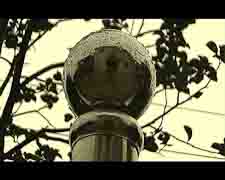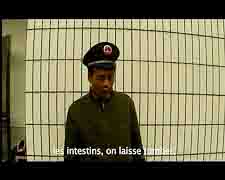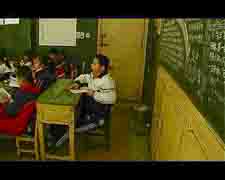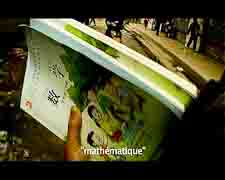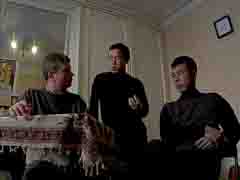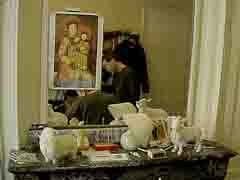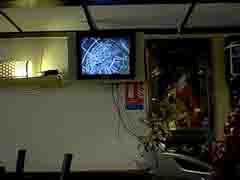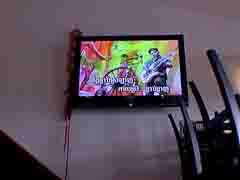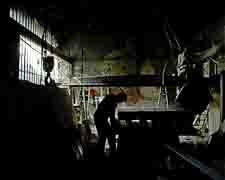Since
painting was the technique that he had learned first, he
submitted drawings and paintings to various Ecoles
des Beaux-Arts in France. Because he was alone, he had made
numerous self-portraits. He was fascinated by Francis Bacon
and Lucian
Freud, artists with a solid technique and a near perfect knowledge
of the human body. Wen Yang Liu needed a live model, which
he couldn’t afford. One day, he found a porno magazine
in a garbage can. He was shocked because China still maintains
a
high level of modesty. But the magazine gave him a starting
point to analyze the human body and he began painting based
on its
illustrations. With these, he was accepted in three different
schools. He decided to go to the Ecole des Beaux-Arts of Valence.
At Valence, he discovered that he was alone in the studio for
painting! No one else was studying painting that semester.
He had no guidance or support from other students, so he decided
to focus on a discipline that required absolute solitude: photography.
Like Alain Marchand later, Monique Deregibus, a professor,
saw
his talent at capturing the essence of an image, and encouraged
him to go further. He took his camera everywhere in the city
and started to take pictures composed like paintings. It was
Alain Marchand who showed him how to go beyond the logic of
a painting. Marchand told him to read an image much as one
would
read a Chinese character: you have to go inside the character
to see the strokes and understand the underlying meaning. It
was a revelation: Wen Yang Liu began to “read” everyday
life.
“What is happening in my images?” Wen Yang Liu says today. “What
is the meaning of this place, these people, these trees, these animals? Suddenly,
my vision becomes confused. I know that I don’t know. I know that I have
to understand. I know that I have to understand the everyday by looking at
people around me, the way they pass me, the way they smile at me, the way they
have
an argument, the way they look sulky. I started to be aware of the small things
in everyday life because I started to look at them, to observe the ordinary.”
His personal journey started there. It was a difficult one from which there was
no return. A radical choice had to be made: to show the ordinary and to connect
the simple stories of daily life, Wen Yang Liu had to capture the perpetual motion
of life and feelings that was unsettled, fluid, turbulent. Only a moving image
would let him reveal through the eye of the camera what we were no longer able
to see. He bought his first computer and downloaded hundreds of films. The Russian
technique influenced him the most.
Dziga Vertov’s 1927 silent film, “The
Man with the Movie Camera,” made
a profound impression.
Dziga Vertov had
developed a radical theory of cinematography, which involved
using visual fragments to create a succession
of small, significant vignettes that revealed a deeper, underlying
reality. Using this theory, Wen Yang Liu began emphasizing
short scenes, rapid sequences and a cinéma verité hand-held
camera technique. This helped him to move from a detailed close-up
to a broader view of the whole, a technique that was often
used in Soviet films.
Wen Yang Liu told us that he considers himself as a “hoodlum” because
he feels like somebody who has no identity, an impression that
shows through all his short movies. After living in France
for almost eight years, he has acquired not only an extraordinary
knowledge of the language but also a sense of his own identity,
even though many questions still need to be answered.
The shock of entering another culture at the age of 18 was
an enormous asset for Wen Yang Liu. In contrast to previous
generations of Chinese artists, he was not forced to leave
China as an exile. His generation was relatively free from
internal trouble. Identity is a central theme in his short
movies, but Wen Yang Liu is able to explore it from both a
Chinese and a Western perspective.
His first experimental film while in school was of a Chinese
friend who was living in a small French village, and renting
a room to an older French woman. The rural French village had
never seen anyone who was Chinese before. When he was invited
to diner, Wen Yang Liu immediately felt the presence of a strange
feeling between his friend and the French lady. At first glance,
their relationship seemed convivial, but at dinner this impression
was quickly replaced by an uncomfortable feeling that an invisible
line divided the table. The French lady ate steak with a fork
and knife; the Chinese friend used chopsticks and ate rice
with vegetables. There was the invisible presence of two incompatible
systems functioning side by side.
“
J’avais 5 ans” (I was 5 years old) is a reflection
on the filmmaker’s growth since he left China. Filmed
in Zhuzhou in 2007, “J’avais 5 ans” is about
memory and the reinterpretation of memory. After the excitement
of returning to Zhuzhou, he feels that the place is older and
more decrepit. In his memory, buildings were clean and white
in contrast to the reality that he now sees. Aging is linked
to nostalgia. He began filming, without really thinking about
a story. He was like a ghost acting behind the camera. His
first effort produced a 60-minute film called “Le Nuage
du Sud” (The Cloud of the South). He quickly realized
that it was too verbose and repetitive. Wen Yang Liu edited
the film into a new version, “J’avais 5 ans.” In
this version, he adopted Russian formalism, in which parallel
sequences reveal an underlying meaning. Wen Yang Liu tells
parallel stories, one of children going to school and the other
involving a goat. At the beginning, the goat is portrayed as
a pet: we see it in a garden or being led down a street like
any domesticated animal. At the same time, we see the children
running down staircases and hurrying along the street on their
way to school. It is a vivid illustration of Wen Yang Liu’s
own past, a way to tell us that he spent a childhood as innocent
as that of a pet. But, quickly, it becomes obvious that the
goat is on its way to be butchered. It is in a sense a sacrificial
animal. It represents the exorcism that the filmmaker had to
experience in order not to fantasize his childhood, his parents,
and his hometown. When the goat is killed, the film takes another
direction: it forces the viewer to experience a ritual of passage.
“
J’avais 5 ans” allows the young filmmaker to find
his own cinematographic expression. It is like a long sentence
with repetitive sounds. In that sense it is a profound reference
to the Chinese language in which one expression automatically
summons another one (nî hâo/ nî hâo/
nî hâo ma?/ wô hên hâo/ etc.)
More than a simple work dealing with memory, this 20-minute
film follows the course of time and raises question about identity.
Identity is also a central and poignant theme in “Le
Trou” (The Hole), a short film made in 2008-2009. Wen
Yang Liu was already at the Ecole Nationale des Beaux-Arts
de Lyon where he is currently enrolled in a post-graduate program.
The film shows a small group preparing a letter to be sent
to the bishop of Lyon. The letter is intended to explain why
these people want to be baptized. Everyone in the group is
Chinese, fragilized in a foreign environment, not knowing the
language or rules. This film parallels Wen Yang Liu’s
personal experience when arriving in Grenoble and feeling completely
isolated, he went to sessions organized by Protestants for
Chinese. At first, he was touched by the message of love expressed
by the Christian religion. But then, he started to read the
Bible and discovered that there were many damned souls for
whom no redemption was possible. He found it difficult to link
the notions of love and damnation, and he left.
“
Le Trou” recounts the personal experience of searching
for the metaphysics of oneself. It also reveals different levels
of perception. When the person playing the role of the translator
says to the French priest that Chinese people do not use the
word “God” but instead say “Sky,” he
simplifies a whole culture because he, himself, does not possess
the complete keys to understand where he comes from. In China,
Taoism, Confucianism and Buddhism have their respective pantheons.
Following the group in Lyon for four months helped him to think
about belief. It helped him to question identity because, as
he explains, “To believe is to enter into a logic, an
identity.”
“
Décalage Horaire” and “Khmer Star Video” are
two other short films that question the notion of identity.
Wen Yang Liu feels that he belongs to a new generation of Chinese
filmmakers, first, because of his age, and second, because
the new way of thinking, neither Chinese nor western, which
he had built in France allowed him to see the world differently.
He feels that previous generations of Chinese artists and filmmakers
focused on their own history and the sufferings they had been
subjected to.
“
Chinese society is becoming more diversified,” he says. “For
me, it is not the physical suffering that is the focal point,
although that is very important. It is ourselves that we need
to find. I think that there is too much hatred in art. The
profound question is to know who I am, who we are. From these
primordial questions the next step is to ask: where do I come
from? Where am I going? This is my point of view as an artist,
as a filmmaker.” This explains why Wen Yang Liu speaks
about art and not about aesthetics. Life is art, and work allows
us to discover what is beautiful. He believes that beauty exists
by itself; we do not have to create it.
“
Yellow Sprite” develops this process further. In 6:55
minutes, we go from pure beauty to the inexorable nature of
life. This short film takes place in the semi-obscurity of
an atelier, filmed with the delicacy of a Rembrandt clair-obscur.
It is a stone cutting workshop and we follow the worker using
assured and repetitive gestures. Water is poured on a stone
just before the cutting with a giant saw. Images are filled
with the noise of the saw and of the water hitting the stone.
Little by little, the image zooms in on a small moving form:
a snail, lost in what looks like the immensity of the sea.
Inevitably, he advances toward the deadly blade. The blade’s
movement is nearly out of sight at first. The camera stays
immobile, as though it were holding its breath. Wide shot on
a minuscule snail, an animal so perfect in its shape, so majestic
in its movement. And we know…death is there…an
atrocious death that will shatter innocence.
With this film, Wen Yang Liu reaches the form and content that
he is looking for. It is a commitment as ‘an artist who
makes films.’ “The documentary is myself,” says
Wen Yang Liu, “It is my memory. It is the reflection
of my memory. On the one hand, I am looking for an artistic
quality but there is always another place called ‘film.’ It
is a constant work of construction-deconstruction.”
To
see" Yellow Sprite, " click here. One
of the three editions of the film has already been bought
by a collector in Paris. To obtain further information
about Wen Yang Liu, please send an email to:
michele@3dotswater.com |



